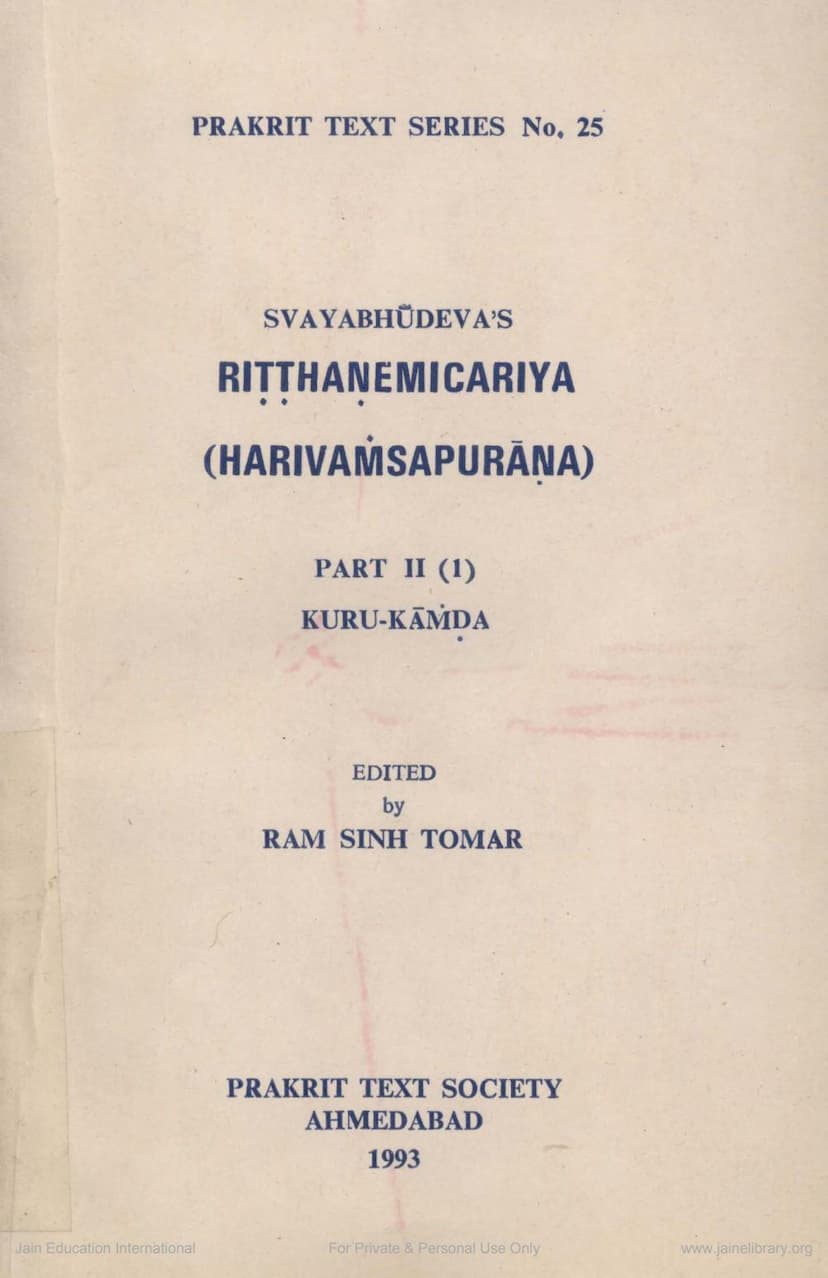Ritthnemichariyam Part 2
Added to library: September 2, 2025
Loading image...

Summary
This document is the Part II (1) Kuru-kāṇḍa of Svayambhūdeva's Rithnemichariyam (Harivamśapurāṇa), edited by Ram Sinh Tomar and published by the Prakrit Text Society, Ahmedabad, in 1993.
Here's a comprehensive summary based on the provided pages:
Overall Context and Significance:
- The book is part of the Prakrit Text Series and is a critical edition of a significant Jain epic written in Apabhramśa.
- Svayambhu (also referred to as Svayambhūdeva) was a prominent Apabhramśa poet who flourished around the late 9th century AD. He is considered one of the foremost Apabhramśa poets, alongside Caturmukha and Puṣpadanta.
- The Rithnemichariyam, also known as Harivamsapurāṇa, recounts the life story of the 22nd Tirthankara, Arisțanemi (Neminath), along with the Jain version of the narrative of Krishna and the Pandavas.
- The epic is vast, comprising 112 cantos (sandhis) divided into four books: Yādava, Kuru, Yuddha, and Uttara.
- The text acknowledges the influence of earlier poets, particularly Caturmukha, who is credited with pioneering the Sandhibandha (epic structure using various metres and sections called sandhi).
- The work was completed by Svayambhu's son, Tribhuvana, who added the last cantos (100-112) when Svayambhu left it unfinished. Later interpolations were also made by Yaśaḥkirti Bhațțāraka in the 16th century.
- The Kuru-kāṇḍa is considered important as the first kāṇḍa to be published in this series, with the Yādava-kāṇḍa already available from another edition.
Key Aspects of the Kuru-kāṇḍa (Part II (1)):
- Content: The Kuru-kāṇḍa covers cantos 14 to 32 of the epic. Its narrative is based on episodes from the Mahabharata, specifically from the Adi Parva, Vana Parva, and Virata Parva.
- Poetic Style and Themes:
- Svayambhu masterfully blends traditional Jain narratives with elements that reflect contemporary society, making his works engaging and popular.
- He is noted for his profound understanding of Indian culture and traditions, evident in many episodes.
- The Kuru-kāṇḍa emphasizes Śr̥ṅgāra (romance/erotic sentiment) and Vīra (heroism) as dominant rasas (aesthetic moods).
- The poet excels in vivid descriptions of nature, cities, and various scenes, which serve as backdrops for the narrative.
- He showcases great narrative skill, selecting particularly poignant and significant moments from the epic tradition.
- Specific Episodes and Characters Highlighted (as described in the Foreword and Introduction):
- Bhishma's Vow of Celibacy (Sandhi 14): Svayambhu praises Bhishma's vow, particularly the aspect of Śrāvaka Vrata (lay ascetic vow).
- Pandu and Madri's Love: The poet vividly describes their passionate relationship.
- Curse on Pandu: The narrative includes the curse on Pandu when he indulges in intimacy with Madri.
- Kunti's Lament (Sandhi 15): The poet poignantly captures Kunti's grief after losing her husband.
- Education of the Pandavas and Arrival of Drona: These dramatic events are presented with skill.
- The Episode of the Ball in the Well: An unknown Brahmin retrieves the ball using a series of arrows, leading to Drona's appointment to teach archery.
- Arjuna's Superiority: Drona recognizes Arjuna as his best student.
- The Archery Competition: Arjuna, Karna, Duryodhana, and others display their skills.
- Karna's Arrival and Challenge: Karna's dramatic appearance and challenge to Arjuna are well-depicted. Duryodhana befriends Karna after this event.
- Karna's Humiliation and Duryodhana's Support: Karna is insulted and then honored by Duryodhana, who grants him the kingdom of Champa.
- Arjuna's Victory over Drupada and Special Favor from Drona: These events solidify Arjuna's position.
- Pandavas' Righteous Conduct: The epic consistently emphasizes the Pandavas' adherence to dharma and good conduct, contrasting it with the Kauravas' cowardice and negative behavior, which leads to their repeated defeats.
- Warriors' Defeats: The narrative details how Arjuna defeats figures like Bhishma, Drona, Kripacharya, and Karna, ultimately disarming Duryodhana.
- Pandavas' Revelation and Recognition: After the battle, the Pandavas reveal themselves. Virat's son recognizes them, particularly Yudhishthira, describing his righteous nature and divine prosperity.
- Abhimanyu and Uttara's Wedding: The Kuru-kāṇḍa concludes with the wedding of Abhimanyu and Uttara, celebrated with the presence of relatives and friends.
- Victory of Dharma: Svayambhu consistently shows the triumph of righteousness.
- Liberal Religious Views: The poet expresses a broad perspective, showing Yudhishthira revering the Arhat (Jina) without distinguishing them from Harihara (Vishnu and Shiva). The poet also invokes Ganga with devotion and remembers Vedic traditions.
- Language and Style:
- Svayambhu's Apabhramśa is described as polished and refined.
- He uses a rich vocabulary with significant Tadbhava (derived from Sanskrit) words.
- The language displays characteristics found in early Hindi, such as independent case markers, compound verbs, and passive voice constructions.
- The poet effectively uses proverbs and idioms that are still current in modern Indian languages.
- His style is characterized by clarity (prasāda guna) and sweetness (mādhura), comparable to Sanskrit Kavyas.
- The use of elaborate and beautiful descriptions enhances the poetic beauty without being ostentatious.
- He skillfully employs figures of speech like Vīpsā (repetition), Utprekṣā (hyperbole/simile), Nidarśanā (exemplification), Rūpaka-tiśayokti (metaphor), Aṅgarūpaka (sustained metaphor), and Antyanuprāsa (end rhyme) in his Kadavaka-style poems.
- Metrical Structure: The epic employs the Sandhi form, with Ghāttās at the beginning and end of each sandhi, and Kadravakas in between. Paddiyā is the common metre in Kadravakas, often interspersed with Dvipadī (couplets).
Editorial Aspects:
- The edition is based on three primary manuscript copies, with detailed descriptions of each, including their provenance, age, and notable features.
- The editor, Ram Sinh Tomar, expresses his gratitude to the Prakrit Text Society and acknowledges the challenges of editing such a vast work.
- The publication plan includes subsequent parts for the Yuddha-kāṇḍa and Uttara-kāṇḍa, as well as a Hindi translation.
- The volume includes a "Shuddhipatra" (errata) indicating corrections to errors found in the text.
In essence, this volume provides scholars with a meticulously edited Apabhramśa text of a crucial portion of a major Jain epic, shedding light on its literary, historical, and religious significance within the Jain tradition.